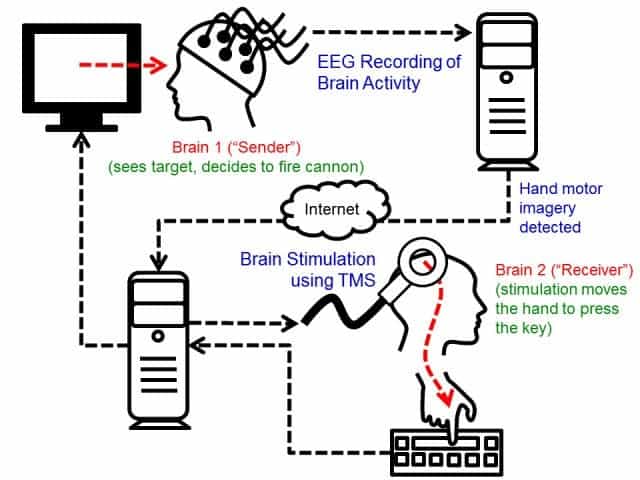In a mind-boggling and, frankly, a bit frightening breakthrough, researchers at University of Washington have devised a brain-to-brain interface that for the first time has allowed the remote exchange of information between two human brains. The test that demonstrated the technology, although simple in nature, shows of a powerful display of force. One researcher (human brain #1), connected through a brain signal reading device sends this signal over the internet to a remotely located researcher (human brain #2) who responds. Namely, brain #1 instructs brain#2 to move his hand and press a key on the keyboard just by thinking about it. Powerful stuff!
Now, similar research has been made before, but only with animal subjects on the receiving end (Harvard researchers controlled the actions of a mouse through a brain-to-brain interface). Also, most importantly the technology devised by the University of Washington researchers is completely non-invasive, requiring no kind of implants or surgery what so ever.
In principle, the schematic of brain-to-brain information exchange is rather simple, exploiting work already employed in the field of medicine, particularly in brain-computer interfaces. Brain #1 is connected to a computer which receives electric signals from the brain via a strapped on special type of EEG, typically employed in brain-computer interfaces. This signal is then transmitted through the internet to a second computer, which picks it up and sends it to brain #2 through a Magstim transcranial magnetic stimulation (TMS) machine – a exciting technology that stimulates specific neurons by electromagnetic induction. TMS set-ups have been used successfully before in the field of medicine to stimulate the activity of regions of the brain associated with depression, or to reduce the activity of a region, which might help with the treatment of other conditions, such as Parkinson’s.

In the experiment, led by Rajesh Rao and Andrea Stocco, a video game is played in which the objective is to hit a target with a canon – both brains are playing the same game in a co-op fashion. Brain#1 doesn’t have any hands-on capabilities and can only watch and think of firing the cannon. Acting as the sender, brain#1 sends the signal over to brain#2 who has his hands over the ‘launch’ key. When stimulated, brain#2 acts and presses the key that launches a cannon ball at the target in the video game. A video presentation is available and can be seen below for a clear picture of how this brain-to-brain technology works.
“It was both exciting and eerie to watch an imagined action from my brain get translated into actual action by another brain,” Rao said. “This was basically a one-way flow of information from my brain to his. The next step is having a more equitable two-way conversation directly between the two brains.”
Now, I know what you’re thinking: mind-control devices; a real life, easy to implement Manchurian candidate. Amazing as the technology may be, claims such as these at this point offer way too much credit to the brain-to-brain interface than its deserves. Chantel Prat, who was also involved in the work, dispels any concerns: There’s no possible way the technology that we have could be used on a person unknowingly or without their willing participation.”
Could you actually send complex information like images, intricate action patterns (collectively twitch your fingers in a desired pattern, move your legs to a certain objective etc.) or verbal thoughts, essentially allowing for a telepathic conversation using this technology? Not yet. We still know very, very little about the human brain. You’d need to know exactly which part of the brain and precisely what neurons to target to relay this kind of information.
“The Internet was a way to connect computers, and now it can be a way to connect brains,” Stocco said. “We want to take the knowledge of a brain and transmit it directly from brain to brain.”
Recently Google unveiled Glass, a pair of high-tech spectacles that offers augmented reality capabilities, allowing the wearer to receive information like brand name, horse power and other technical aspects of a car just by looking at it for instance. In time, such technology might become not only as common as smartphones are today, but even more powerful. It’s not completely insane to image a world in a not so distance future in which people voluntarily have implants that allow the recipient to receive complex information like that relayed by Google Glass directly into the brain. The capabilities then seem endless and, again, terrifying at the same time. Not here to throw gas on conspiracy theorist fires, but I can’t help but entertain the idea.
source






